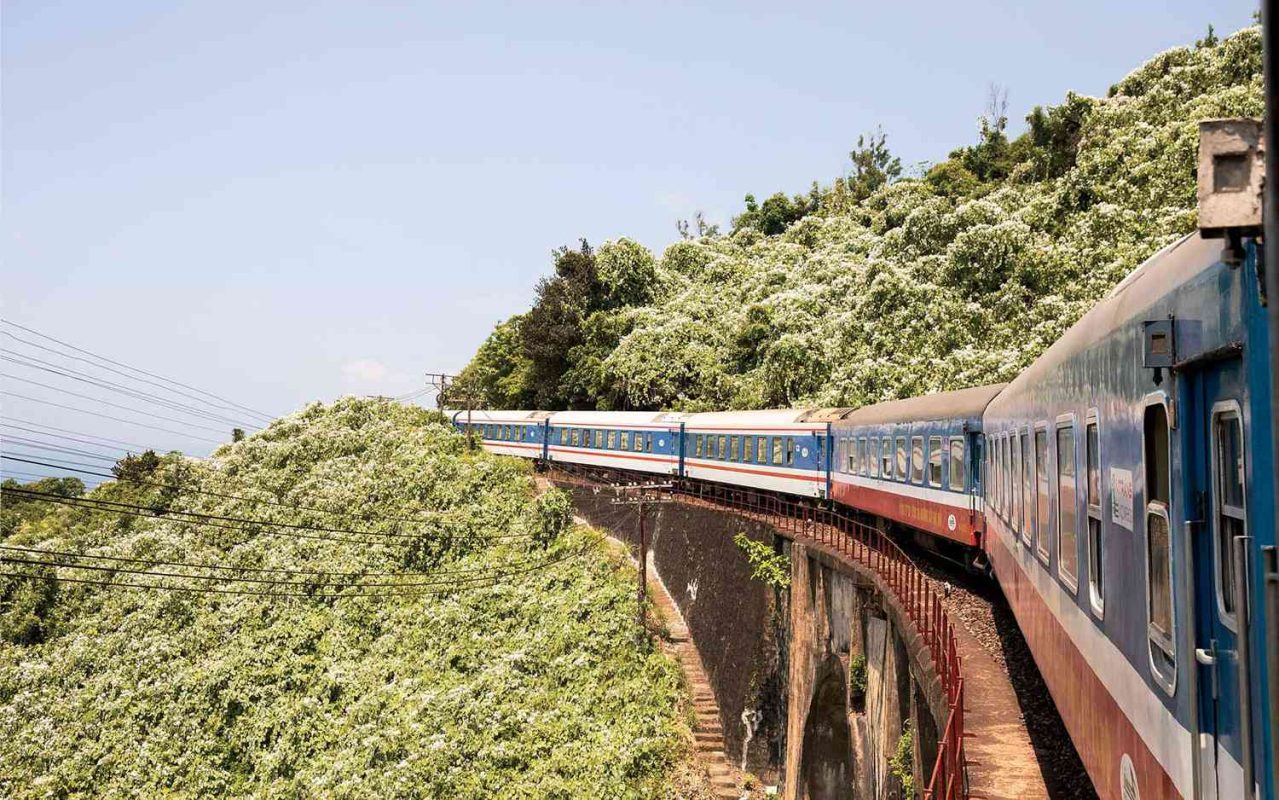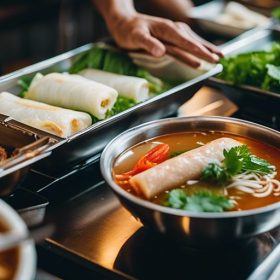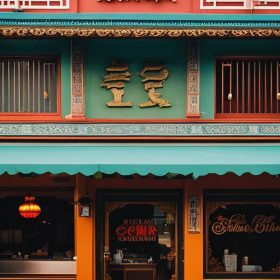Vietnam’s railway system is an integral part of the country’s transportation infrastructure. It spans over 2,600 kilometers and connects major cities and towns across the country. The railway system in Vietnam plays a crucial role in transporting both passengers and goods, providing a convenient and affordable mode of transportation for locals and tourists alike.
Trains have been a popular mode of transportation in Vietnam for many years, offering a unique way to experience the country’s diverse landscapes and vibrant culture. From bustling cities to picturesque countryside, traveling by train allows passengers to witness the beauty of Vietnam while enjoying the comfort and convenience of rail travel.
The History of Railway Food in Vietnam
The history of railway food in Vietnam dates back to the early 20th century when the French colonial government introduced trains to the country. During this time, dining cars were introduced on long-distance trains, offering passengers the opportunity to enjoy meals while traveling.
Over the years, railway food in Vietnam has evolved to cater to the changing tastes and preferences of passengers. In the early days, meals served on trains were simple and consisted mainly of rice, vegetables, and meat. However, as Vietnam opened up to international influences and tourism increased, the variety and quality of railway food improved significantly.
The Importance of Railway Food in Vietnamese Culture
Food holds great significance in Vietnamese culture. It is not just about sustenance but also a way to connect with others and express hospitality. Sharing a meal is considered a social activity that brings people together, and this is reflected in the importance placed on food in Vietnamese culture.
Railway food plays a significant role in preserving and showcasing Vietnamese culinary traditions. It offers passengers a taste of authentic Vietnamese cuisine while they travel through different regions of the country. From street food-inspired snacks to regional specialties, railway food provides a unique culinary experience that reflects the diversity and richness of Vietnamese culture.
The Different Types of Trains and Their Food Offerings
Vietnam’s railway system consists of various types of trains, each offering different levels of comfort and amenities. The food offerings on these trains vary depending on the type of train and the duration of the journey.
The Reunification Express is the most popular train in Vietnam, running from Hanoi to Ho Chi Minh City. It offers a range of food options, including both Vietnamese and international cuisine. Passengers can choose from a variety of dishes, such as pho (Vietnamese noodle soup), banh mi (Vietnamese sandwich), and com tam (broken rice).
For shorter journeys, local trains are a popular choice. These trains typically have limited food options, with vendors selling snacks and drinks onboard. Passengers can enjoy local favorites like banh bao (steamed buns) and banh trang nuong (grilled rice paper).
The Best Dishes to Try on Vietnam’s Trains
When it comes to railway food in Vietnam, there are several dishes that are a must-try for any food lover. One of the most iconic dishes is pho, a flavorful noodle soup made with beef or chicken broth, rice noodles, and various herbs and spices. Pho is a staple in Vietnamese cuisine and is often enjoyed for breakfast or as a light meal.
Another popular dish to try on Vietnam’s trains is banh mi. This Vietnamese sandwich is made with a crispy baguette filled with various ingredients such as grilled pork, pate, pickled vegetables, and fresh herbs. Banh mi is a delicious and convenient option for a quick meal on the go.
For those looking for something more substantial, com tam is a great choice. This dish consists of broken rice served with grilled pork chop, shredded pork skin, and a fried egg. Com tam is often accompanied by pickled vegetables and fish sauce, adding a burst of flavor to the dish.
Regional Specialties Served on the Rails
One of the highlights of experiencing railway food in Vietnam is the opportunity to try regional specialties from different parts of the country. Each region in Vietnam has its own unique culinary traditions and flavors, and these are reflected in the dishes served on trains.
In the north, passengers can enjoy dishes like bun cha, a popular Hanoi specialty made with grilled pork, rice noodles, and a flavorful dipping sauce. Another northern favorite is banh cuon, steamed rice rolls filled with minced pork and mushrooms, served with a side of fish sauce.
In central Vietnam, passengers can savor dishes like mi quang, a noodle dish made with turmeric-infused noodles, shrimp, pork, and various herbs and vegetables. Another regional specialty is banh xeo, a crispy pancake filled with shrimp, pork, bean sprouts, and herbs.
In the south, passengers can indulge in dishes like hu tieu, a noodle soup made with pork or seafood broth and topped with various ingredients such as sliced pork, shrimp, and quail eggs. Another southern specialty is banh khot, bite-sized pancakes made with rice flour and coconut milk, topped with shrimp and served with a sweet and tangy dipping sauce.
Vegetarian Options on Vietnam’s Trains
For vegetarian travelers or those looking for meat-free options, there are plenty of vegetarian dishes available on Vietnam’s trains. Many Vietnamese dishes can be easily adapted to be vegetarian-friendly by substituting meat with tofu or vegetables.
One popular vegetarian dish to try is banh mi chay, a vegetarian version of the traditional banh mi sandwich. It is made with tofu or seitan instead of meat and is filled with pickled vegetables, fresh herbs, and vegan mayonnaise.
Another delicious vegetarian option is pho chay, a vegetarian version of the classic pho noodle soup. It is made with vegetable broth, tofu, and a variety of vegetables and herbs. Pho chay is a comforting and flavorful dish that is perfect for vegetarians.
The Role of Street Food in Vietnam’s Railway Stations
Street food is an integral part of Vietnamese culture, and it is no different in railway stations. Many railway stations in Vietnam have bustling street food stalls and vendors selling a variety of snacks and meals.
Travelers passing through railway stations can indulge in popular street food dishes like banh mi, banh bao, and banh trang nuong. These street food snacks are convenient and delicious options for a quick bite while waiting for a train or during a layover.
The integration of street food into railway stations not only provides passengers with a wide range of food options but also adds to the vibrant and lively atmosphere of these transportation hubs.
Tips for Enjoying a Culinary Journey on Vietnam’s Trains
To make the most of a culinary journey on Vietnam’s trains, here are some tips to keep in mind:
1. Research the different types of trains and their food offerings before booking your ticket. This will help you choose the train that best suits your preferences and dietary requirements.
2. Pack some snacks and drinks for longer journeys, as there may be limited food options available onboard.
3. Take the time to explore the street food stalls in railway stations. This will give you the opportunity to try a variety of local dishes and flavors.
4. Don’t be afraid to try new dishes and flavors. Vietnamese cuisine is diverse and delicious, so be adventurous and sample as many dishes as you can.
5. Engage with locals and fellow passengers to learn more about the food culture in Vietnam. They can provide valuable insights and recommendations for must-try dishes.
The Future of Railway Food in Vietnam
As Vietnam’s railway system continues to evolve and modernize, so does its food offerings. With the increasing popularity of train travel among tourists, there is a growing demand for more diverse and high-quality food options onboard.
In recent years, there has been a focus on promoting local and sustainable food on trains. This includes sourcing ingredients from local farmers and producers, as well as offering organic and vegetarian options. The railway system in Vietnam is also exploring partnerships with local restaurants and food vendors to provide passengers with a wider range of food choices.
Why You Should Experience Vietnam’s Railway Cuisine
Experiencing railway food in Vietnam is not just about satisfying your hunger, but also about immersing yourself in the country’s rich culinary traditions and vibrant culture. From the iconic dishes like pho and banh mi to the regional specialties served onboard, railway food offers a unique and authentic taste of Vietnam.
Whether you are a food lover or simply looking for a memorable travel experience, exploring Vietnam’s railway cuisine is a must-do on your trip to the country. So hop on a train, sit back, and enjoy the flavors of Vietnam as you journey through its picturesque landscapes and bustling cities.

Cuong Nguyen is a talented writer and experienced waitress at Vietnampalace.net, a renowned Vietnamese restaurant that offers an extensive menu of authentic Vietnamese cuisine. With a background in the competition of Vietnamese cuisine, Cuong brings a wealth of knowledge and expertise to the dining experience. From delicious pho dishes to fresh spring rolls, Cuong ensures that every meal is made with the freshest ingredients and authentic flavors.With exceptional service and a friendly atmosphere, Cuong takes pride in providing a memorable dining experience for every customer.
Whether you’re a vegetarian looking for options or a meat lover craving the flavors of traditional Vietnamese dishes, Cuong guarantees a delightful culinary adventure. So, visit Vietnampalace.net and let Cuong guide you through the tantalizing world of Vietnamese cuisine.



